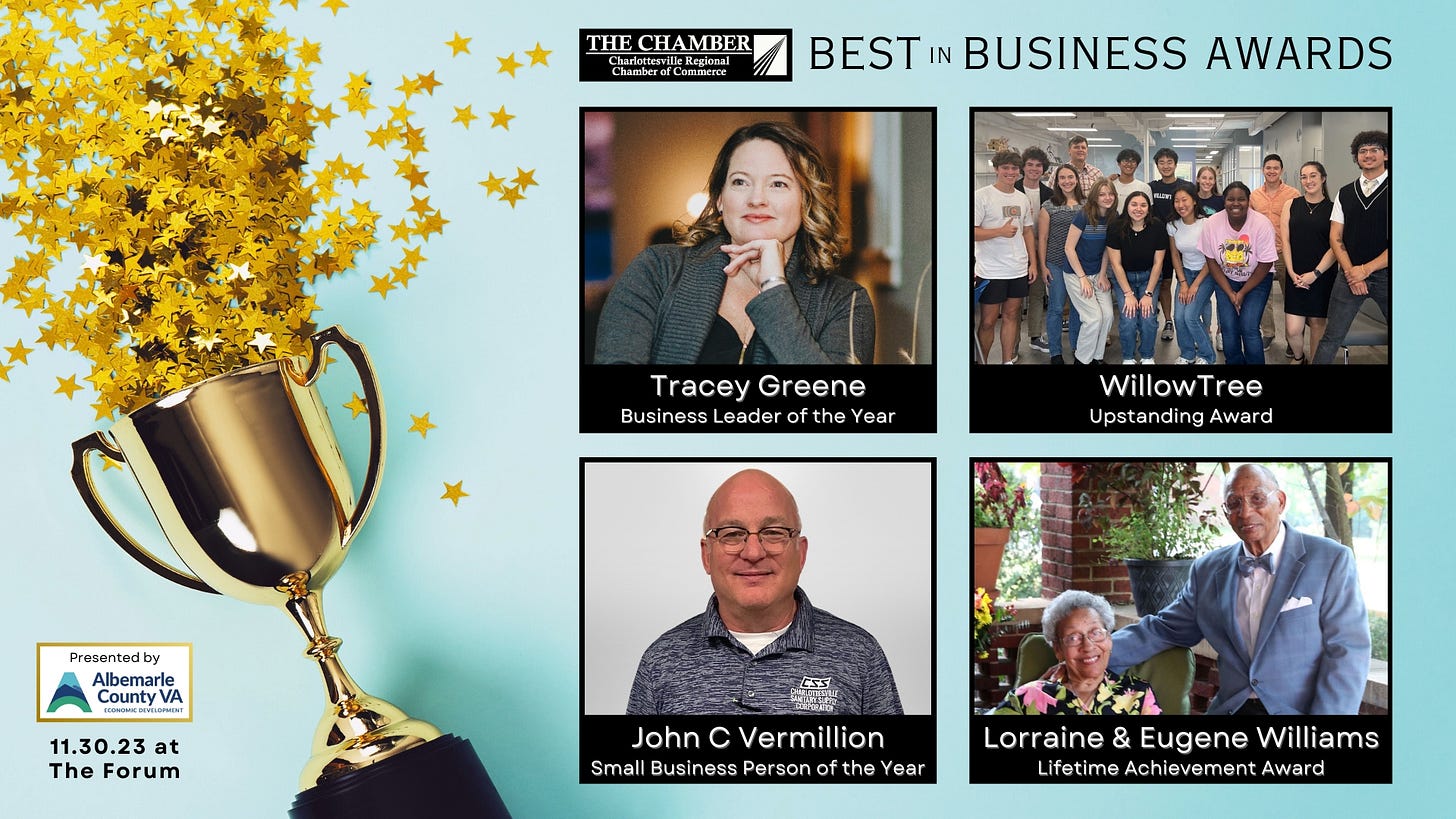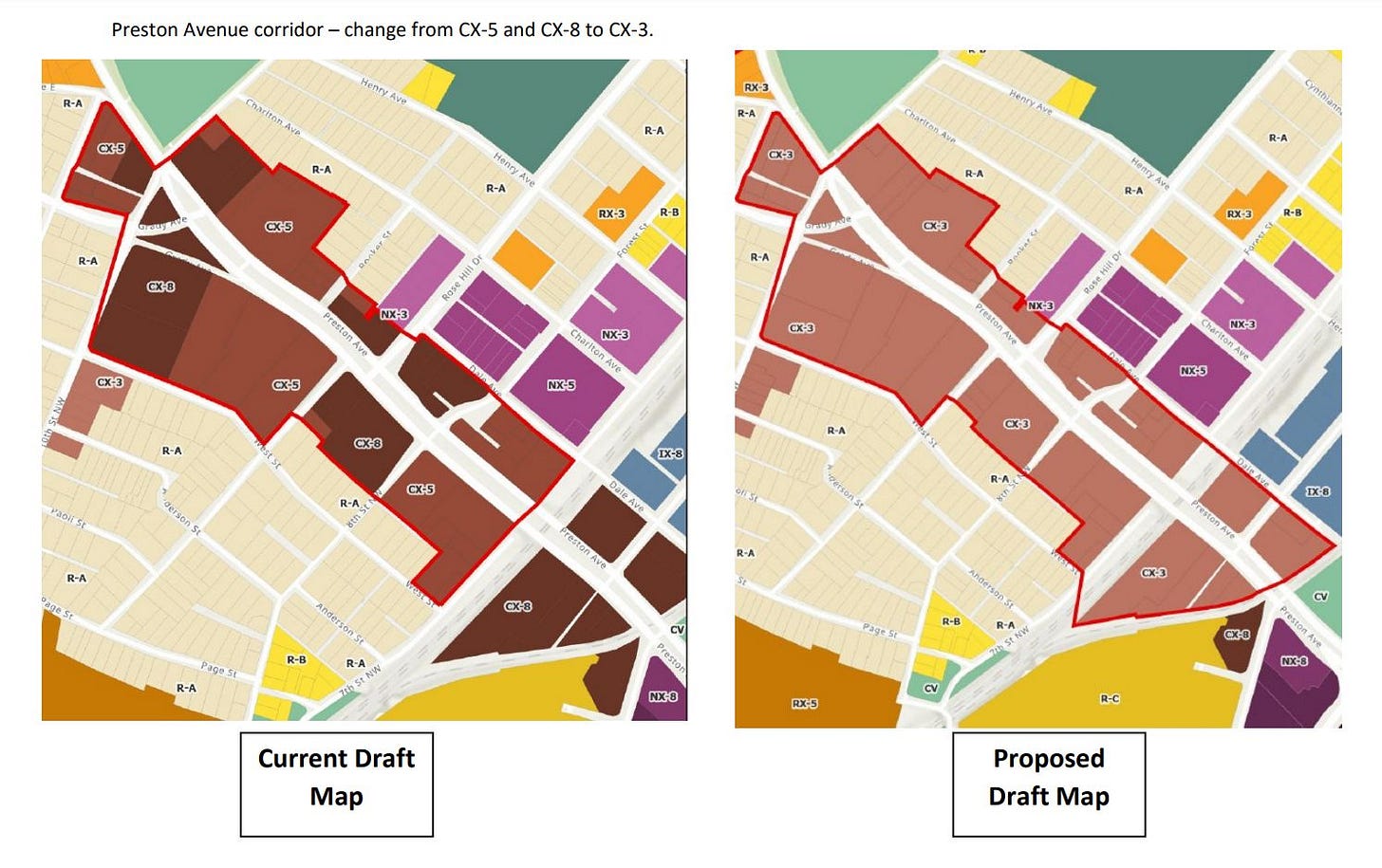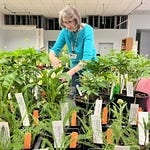Among other things, November 15 is apparently National Ample Time Day. Here’s hoping that you have enough time to get through this edition of Charlottesville Community Engagement, a newsletter and podcast that takes a certain amount of time to create and the word “ample” may not quite be congruent. I’m Sean Tubbs, recent purchaser of a dictionary.
In this edition:
Northrop Grumman is opening an advanced testing facility in Waynesboro and the hope is to create 300 jobs
Eugene and Lorraine Williams will receive the Chamber of Commerce’s Lifetime Achievement Award
A quick construction update from the University of Virginia
City Council indicated at their November 1, 2023 City Council work session on the Development Code they may support reintroduction of discretionary review for height increases in commercial corridors
First shout-out: Magic on the Mall
In today’s first Patreon-fueled shout-out: The holidays are fast approaching and the Friends of Charlottesville Downtown and the Charlottesville Albemarle Convention and Visitors Bureau are gearing up for another season of Magic on the Mall!
Beginning on Saturday, November 25, there will be something for every member of the family!
The Jolly Holly Trolley will be running up and down the Mall from 10 a.m. to 2 p.m. Saturdays and Sundays through December 23
You can take free Selfies with Santa from 10 a.m. to 2 p.m. on Saturday, November 25th and December 16th
Go on a magical scavenger hunt to find the Elves in Cville by starting at Charlottesville Insider or downloading it online!
Follow the Peppermint Trail where you can find all sorts of treats! Locate the map here!
Downtown businesses will have a festive face off in the Best in Snow window competition, and you can vote for the jolliest!
Celebrate on December 10 with the Chabad House of UVA the fourth night of Hanukkah with a menorah lighting and traditional foods
Visit friendsofcville.org to learn more!
Northrop Grumman to open testing facility in Waynesboro
Military contractor Northrop Grumman will invest $200 million to build an advanced electronic manufacturing and testing facility in the City of Waynesboro with an eye toward creating more than 300 jobs within five years.
The private company’s decision has been helped along by an $8.5 million from the Commonwealth’s Opportunity Fund that will assist the city government. The news was announced this morning by Governor Glenn Youngkin.
Applicants for those jobs will be fueled by the Virginia Talent Accelerator Program, an initiative of the Virginia Economic Development Partnership.
“Launched in 2019, the program accelerates new facility start-ups through the direct delivery of recruitment and training services that are fully customized to a company’s unique products, processes, equipment, standards, and culture,” reads a press release for the announcement.
According to its website, Northrop Grumman has over 100,000 employees in space, aeronautics, defense, and cyberspace with corporate headquarters in Northern Virginia. Take a look at their current job opportunities.
Chamber of Commerce announces 2023 business awards
The Charlottesville Regional Chamber of Commerce will hand out four annual awards at a gala on November 30, 2023 and one of them is to a couple who have been involved with the civil rights movement locally and who later worked to preserve affordable places to live.
“In the 1950s and 60s, [Eugene and Lorraine Williams] organized sit-ins, helped the Charlottesville branch of the NAACP grow exponentially, and spearheaded a lawsuit to integrate City schools,” reads a November 9 press release announcing the awards.
The Williams will receive the Lifetime Achievement Award. The couple created Dogwood Housing in the 1980’s to preserve homes for existing residents. Earlier this year, the Charlottesville Redevelopment Housing Authority purchased over 70 units to keep them affordable.
The other awards are:
The Christopher Lee Small Business Person of the Year is John Vermillion, the president of Charlottesville Sanitary Supply Corporation.
WillowTree will receive the Upstanding Award for business practices including efforts toward “sustainability, volunteerism, charitable giving, and diversity and equity initiatives.”
The Business Leader of the Year will go to Tracey Greene, the executive director of the Charlottesville Business Innovation Council and the founding executive director of the Charlottesville Angel Network.
The awards dinner will be held at the Kimpton Forum Hotel at Darden on November 30. Purchase tickets here.
Renovation of Alderman Library at UVA nearing completion
The beginning of any Charlottesville Planning Commission meeting is a chance to learn more about what’s happening in the built environment through reports from Commissioners.
At the November 14 meeting, Bill Palmer in the University of Virginia’s Office of the Architect said he did not have a big report and that the next meeting of the Board of Visitors is not until December. He did have a few updates.
“The main library is nearing completion and got its temporary occupancy permit which is a big milestone so they can start occupying the building and bringing stuff in like books and stuff like that,” Palmer said.
Palmer said April is the estimated time for completion. He also had an update on a project built on the banks of the Dell.
“Contemplative Commons which is also over that way is nearing completion,” Palmer said. “I don’t know the exact date on that, but winter and spring of 2024.”
The second student residential building in the Brandon Avenue corridor is also under construction with another 300 beds and should be ready for students to move in fall 2024. The two wings will be named Gaston House and Ramazani House to reflect the names of two late professors. (read my story) (read the C-Ville Weekly version)
Turning to the Ivy Corridor, the School of Data Science is almost complete but other projects will soon get underway. These are the Hotel and Conference Center has broken ground and the Karsh Institute of Democracy is still in design.
Two items that Palmer didn’t mention have previously been covered in this newsletter.
UVA purchases Oak Lawn property, October 18, 2023
UVA seeks firms to conduct planning study for Grove Street properties, November 9, 2023
More from the Planning Commission in future editions of the newsletter.
Second shout-out: Live music on WTJU
In today’s second Patreon-fueled shout-out: WTJU provides great music for the community every hour of the week, including live performance broadcasts by area artists. Get your calendar ready to mark down some of those times!
Every third Saturday, WTJU hosts "Third Rail," a live music series that pushes genre boundaries. On November 18, the station will host Free Pony, a post-punk quartet from Charlottesville. This concert and all other Third Rail programs are broadcast live on WTJU, live video streaming at WTJU's YouTube channel, and are free for anyone to attend in person at 2244 Ivy Road.
And every Friday night, WTJU hosts a live music series called "Offbeat Roadhouse," featuring mostly acoustic artists -- folk, blues, jazz, americana, and beyond. This Friday features BB3, or the Bob Bennetta Three. That’s a live concert that is free and open to the public. Check out the schedule at WTJU for more information.
Council willing to reintroduce discretionary review process back into Development Code for additional height in commercial districts
Since getting back to journalism in the summer of 2020, I’ve tried to document as much as I can about the Cville Plans Together initiative. That’s the name given to the land use reform process ordered by City Council back in February 2019.
City Council adopted an Affordable Housing Plan in March 2021 and followed that up with adoption of a Comprehensive Plan in November. Both called for the rewriting of the city’s zoning code to make it easier for developers to build more units and to dedicate at least $10 million a year towards the production and maintenance of affordable housing.

The zoning update is now officially known as the Development Code and the Charlottesville Planning Commission made its recommendation for approval on October 18. Since then, City Council has been holding a series of work sessions to inform their vote. A final work session is scheduled for November 29 followed by a public hearing on Tuesday, December 5.
Before then, I hope to create at least one long overview of how we got to this point but I’ve still got to sift through the work sessions from November 1, November 8, and November 13. These meetings are long and I’ve tried to listen to every word.
Before we get to November 1, I should say I’m also behind with the property transactions and I’ll have a summary of September transactions available for a first look for paid subscribers sometime before Thanksgiving. I take a look at every single property in Charlottesville and have published summaries since January 2021. Take a look at the archive.
Why do I do it? To document what’s happening to understand the sheer amounts of money that can be made off of real estate if you know how to play the game. I don’t, and I reckon most people don’t either.
Here’s an observation from Charlottesville Mayor Lloyd Snook at the very beginning of the November 1, 2023 work session on the Development Code.
“The greatest profit margin for somebody to do this and to buy up something and basically take it out of the market for those who want to simply buy and own in that neighborhood, the greatest incentive for that to happen is going to be in this 10th and Page area, Fifeville area,” Snook said.
The Future Land Use Map of the Comprehensive Plan designated portions of these areas as “Sensitive Communities” in order to create policies that would seek to slow or prevent displacement of Black residents. After staff suggested not creating a special category in the new zoning code, the Housing Advisory Committee has been advocating that certain parts of these areas get fewer development rights to make them less attractive to investors. (Charlottesville City Council pitched on restoration of “anti-displacement zones”, October 16, 2023)
These are known as the Residential Core Neighborhood A and as a base would only one residential unit per lot, unless an existing building is kept. Then there can be a total of two additional units. Contrast that with Residential-A, where a property owner would get three units by-right.
Over the last decade or so, many properties in those two neighborhoods and the Rose Hill neighborhood have been picked up by investors for relatively low prices and many have been flipped for much, much more.
“Tenth and Page used to be a distinct neighborhood that extended up to 12th and 13th and now what we would call Tenth and Page doesn’t extend in terms of the Black community that had been living there for generations, they’re not there on 13th Street anymore, or 12th Street anymore,” Snook said. “There are an awful lot of students in there.”
At the same time, Snook said he’s heard many arguments from people who say that the Residential Core Neighborhood A District takes away the ability for people who live there now to maximize the amount they can get for the property should they choose to sell.
“Mama lived there for 50 years and she died and none of the kids want to live there and the kids want to sell the house, why shouldn’t they be able to maximize their profit?” Snook said. “Their generational wealth is embodied in that house and you’re saying is that you can’t access that. For some folks, that would seem to be just as much a racial issue as the composition of the neighborhood.”
As the November 1 meeting began, he said he was torn between the two views and drew upon his experience as an attorney writing up people’s wills.
City Councilor Michael Payne said he understood that tension but said there would still be an increase in development rights in the R-NA district over what’s allowed now.
City Councilor Brian Pinkston said the extent of the R-NA zones in the draft map was much larger than he had anticipated. He supported its inclusion in the draft that will go to Council for their public hearing.
“I feel like this is really big and probably the most difficult issue conceptually to try to work through,” Pinkston said. “There were lots of people who gave lots of input, both through the [Housing Advisory Commission] and the [Planning Commission] and I feel like with your staff as well James that you all came up with what you thought was a good compromise. It’s not perfect. There’s definitely going to be the trade-off that was mentioned between whether a person is able to fully take advantage of selling out their equity where they are now versus if we aren’t careful, all of these neighborhoods will be eroded by gentrification.”
Pinkston also supported the overlay district for Preston Avenue and Cherry Avenue that was introduced after the Planning Commission’s public hearing on September 14. Under this concept, developers would have to seek a special exception permit for additional height. This is a different process from the special use permit process that’s been used for years for that purpose.
“What’s being proposed for the corridors is responsive to the concerns that were brought to us about the Dairy Market project when we had all of the people showing up at out Planning Commission meeting back in August,” Pinkston said.
Vice Mayor Juandiego Wade said he was mostly concerned about preventing displacement in what the Future Land Use Map referred to as “Sensitive Communities.” He said he has been meeting with people who are concerned the new Development Code won’t deliver what has been promised.
“If we go through all of this and we still lose our neighborhoods, it would just really be tough,” Wade said. “I know it’s hard if someone comes to someone and says ‘we’ll give you a million dollars for your property’, there’s no ordinance in the world that would prevent something like that.”
Payne expressed concern that other areas of the city designated to be in the new mixed-use districts will hurt the fabric of existing small businesses. He indicated he might support expanding the overlay districts in part because the special exemption process would give more voice to nearby residents.
“In some areas that may be fine,” Payne said. “I understand there is the idea to move away from discretionary processes and there’s a trade-off in terms of cost there. But there is still a part of me that just wonders what’s outlined, what is the great fear that there’s a special use permit equivalent in some areas where you’re talking about a change to ten stories, or eight stories, where the existing conditions might be 35 feet by-right?”
Pinkston said he could see the East High Street corridor being another that could use the additional step for additional density. Payne said he would like to see more protections given to the city’s existing mobile home parks.
“My thinking is that if the goal is to try to prevent displacement of renters, the ideal would be if you could find specific parcels that have a high percentage of low-income renters with no subsidy, my concern is that at mobile home parks, you change the zoning to allow to unlimited density, five stories with a height bonus, if that increases the value of the parcel by a hundred percent and the owner sells it, all those people are screwed and they’re never going live here again,” Payne said.
At the November 1 meeting, Councilors reached consensus on the language that’s being suggested for the R-NA. They did not reach consensus on the map for that area which means that will likely not be part of the public hearing. They also left unresolved how far the Preston Avenue overlay district should extend to the east.
Hearing what Payne had had to say, Neighborhood Development Director James Freas asked the five Councilors if they supported the idea of requiring a special use permit for anything over five stories.
Snook said there were a couple of competing tensions.
“One tension is that every time we end up talking about SUPs it slows the process down and causes more expense for applicants,” Snook said. “On the other hand, it also gives the government and the planners more control over the process and the idea is that we may not be able to so finely tune our zoning ordinance that we can say with certainty which results we would always find to be acceptable.”
Snook asked if there was a third way in between. Freas said that wasn’t likely and that the permit process introduces risk to both the developer and the city, because the city has to invest time in staff to review the work before it gets to the legislative process.
Pinkston said he supported the idea, but noted it was counter to much of the thrust of the Cville Plans Together initiative.
“The idea that the architects as it were of this whole enterprise, one of their main criteria was that we would get out of the business of having so much paperwork for lack of a better word and people would have a pretty good sense of what they could build by-right by essentially looking at the zoning map,” Pinkston said.
Pinkston said he would support the additional review if it assuaged Payne’s concern.
“We’ve spoken a lot about displacement of people and now we’re shifting to discussions of displacements of businesses, which is important too,” Pinkston said.
Freas said the special exemption process will also introduce risk which might dissuade developers from moving forward with projects.
“They would also point out that the other uncertainty is in the form of the conditions that might arise,” Freas said. “What conditions am I going to get that are going to blow my proforma? That’s one of the things we’re trying to frontload into the ordinance.”
Under the proposed Development Code that’s been under review since February, additional height above the by-right allowance is only granted if there are affordable units.
“The RX, CX, NX, IX, in all of those, there is a bonus height that you’re able to seek in exchange for providing that affordable dwelling unit at 50 percent of [area median income],” Freas said. “So the base requirement that everybody has to do without any bonus is 60 percent of AMI, ten percent of units at 60 percent of AMI. If you drop down to 50 percent of AMI, that’s when you get the bonus.”
Those rules will be codified within the Affordable Housing Manual which was the subject of the November 13 work session.
At the very end of the work session, at least two Councilors signaled a willingness to reintroduce the concept of the special use permit back into the Development Code at least so it can be discussed at the public hearing.
“Let’s go ahead and put it in the advertisement,” Wade said. “We may not do it. That’s what I say.”
“For a commercial use of more than five stories, there would have to be a special use permit?” Snook said.
“Yes,” Wade answered.
“So we’re saying any use in those districts over five stories?” Freas said.
“That’s what I was thinking and the reason for that is to say a commercial use, we’d get into the issue of well, suppose it’s three stories commercials and four stories that are going to be residential,” Snook said. “Is that a commercial use or a residential use? Let’s not have that argument. As least not right now.”
I’ll have a summary of the November 8 work session before the end of the week. September property transactions? Hopefully soon!
Reading material:
Virginia House Republicans stick with Todd Gilbert as their leader after election loss, CBS19, November 13, 2023
With all election numbers in, a look at how Nelson County voted, Emma Martin, Nelson County Times, November 13, 2023
In Virginia, local govts increasingly eye speed cameras to slow school and work zone traffic, Nathaniel Cline, November 14, 2023
Project for ten-story apartment building off Ivy Road moves forward, Maggie Glass, NBC29, November 15, 2023
Planning Commission recommends approval for Ivy Road development, Garrett Whitton, CBS19, November 15, 2023
Expository thoughts for #602
Readers who do not listen to the podcast may know not there are listeners who never read the newsletter. This makes me wonder if it’s time to begin producing this in a third medium. Either way, I am making an effort to remix the concluding audio today based on the notes of a listener. No matter how you read this, drop me a line at info@infocville.com if you have feedback.
I have been neglecting mentioning the importance of Wraki to the podcast version of this newsletter. The bridge music is almost all composed by this mysterious luminary of the sonic variety, and there are two items available for free on BandCamp. I’ve also heard rumor there may soon be a retrospective podcast hosted behind the Patreon paywall documenting the elusive Wraki. That’s something that should happen, at least.
I also want to give an end-of-the-show shout-out to Ting for their sponsorship of this newsletter and podcast. The Internet provider supports a lot of things in the area, including Crazy fast fiber Internet for their customers.
Maybe you’re in the market for a new high speed internet provider? If so, check out Ting! If you sign up for Ting at this link and enter the promo code COMMUNITY, you’ll get:
Free installation
A second month for free
A $75 gift card to the Downtown Mall



















Share this post